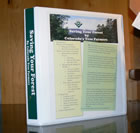|
Education>Master
Tree Farm Course> Tree Farm Technician>
BEST MANAGEMENT PRACTICES
Objective: To provide information to the Tree Farmer so
that a reasonable understanding of why Best Management Practices (BMPs) are both
necessary and required by law. Section
208 of the Federal Water Pollution Act of 1972 requires that pollutants of
rivers, streams, and other bodies of water within the U.S. be controlled at the
sources. Procedures have been
developed so that owners of forest land and their contractors may comply
voluntarily with provisions of the Federal Water Pollution Control Act. This voluntary approach to the elimination of water pollution is less
frustrating and expensive than a compulsory program of regulations, inspections,
and permits.
The Water Quality Act of 1987 (PL-100-1, Sec. 319)
considers a BMP as any method , measure or practice used to reduce water
pollution to include, but not limited to, control of water caused erosion.
Forestry BMPs encompass six basic goals in order to meet
Water Quality Standards and the goals of the Clean Water Act.
| 1. To minimize surface runoff waters originating from any type of
forestry-related soil disturbance and
running directly into a water course. |
| 2. To maintain the integrity of all stream beds and banks.
|
| 3. To prevent depositing of logging debris in stream banks. |
| 4. To prevent chemicals, pesticides, fertilizers or petroleum products
from entering or degrading (directly or indirectly) streams, ground water or
surface water. |
| 5. To establish streamside management zones (SMZs) along perennial water
courses that filter sediment from overland flow and maintain stream
temperature. |
| 6. To provide for rapid revegetation of all exposed mineral soil areas
through natural processes supplemented by artificial revegetation where
necessary. |
Utilize the publication Colorado
Forest Stewardship Guidelines to Protect Water Qualilty: Best Management
Practices (BMPs) for Colorado, 2/98.
Master Tree Farm Course Tree Farm Technician
|



